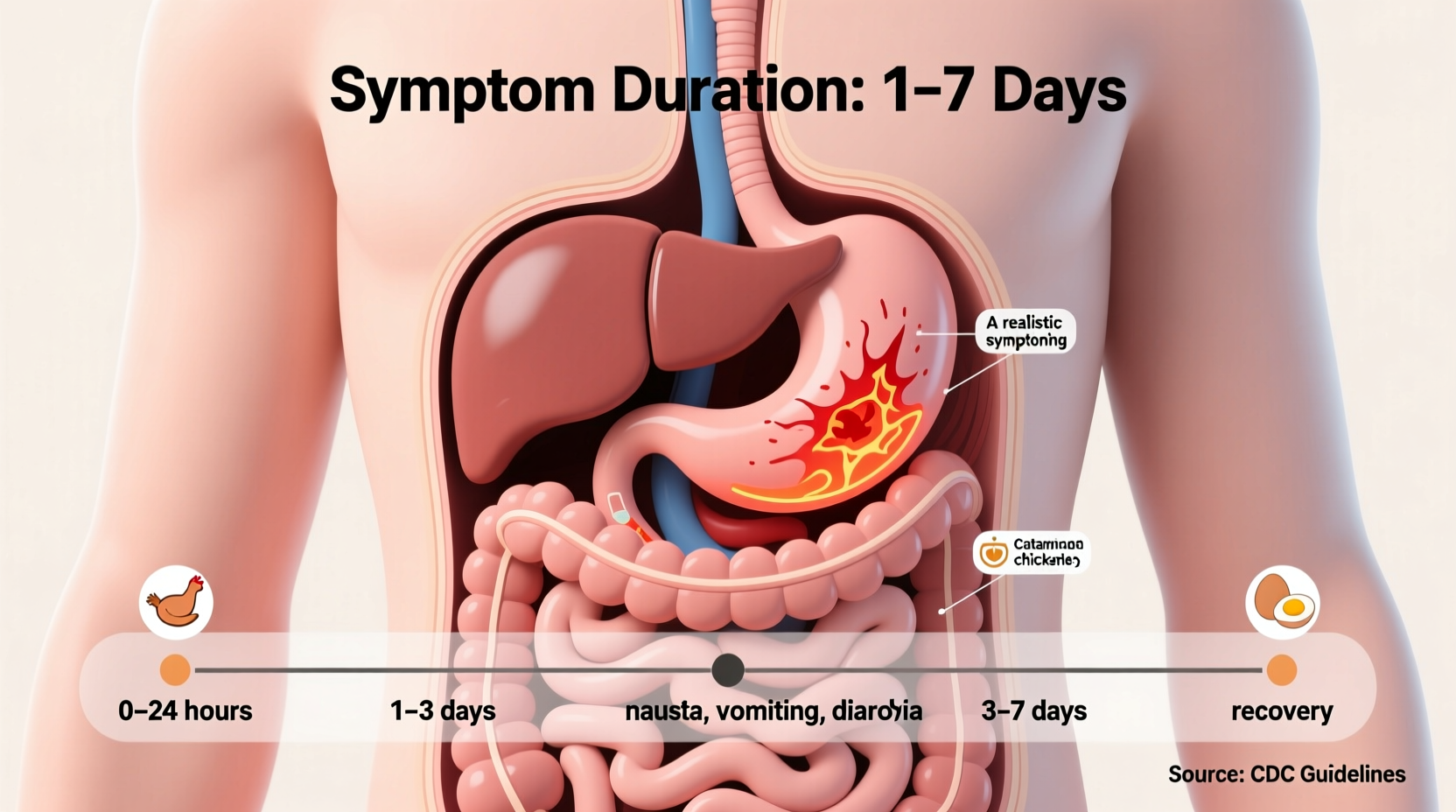When food poisoning strikes, knowing how long do the effects of food poisoning last helps you determine whether your symptoms are normal or require medical intervention. Understanding the typical duration for different pathogens empowers you to make informed decisions about your recovery process and when to seek professional help.
Food Poisoning Timeline: How Long Symptoms Last by Pathogen
The duration of food poisoning symptoms depends primarily on the specific pathogen causing your illness. This timeline provides evidence-based expectations for common foodborne illnesses:
| Pathogen | Incubation Period | Typical Duration | High-Risk Groups |
|---|---|---|---|
| Norovirus | 12-48 hours | 1-3 days | Young children, elderly |
| Salmonella | 6-72 hours | 4-7 days | Infants, immunocompromised |
| E. coli (STEC) | 3-4 days | 5-10 days | Children under 5, elderly |
| Listeria | 1-4 weeks | 1-3 weeks | Pregnant women, newborns |
| Campylobacter | 2-5 days | 2-10 days | Immunocompromised individuals |
This comprehensive timeline of food poisoning duration comes directly from Centers for Disease Control and Prevention (CDC) surveillance data, which tracks foodborne illness patterns across the United States. The CDC's National Outbreak Reporting System provides these evidence-based timeframes that healthcare professionals use when assessing potential food poisoning cases (cdc.gov/foodsafety/outbreaks).
Factors That Influence How Long Food Poisoning Lasts
While pathogen type is the primary determinant of symptom duration, several other factors significantly impact how long do food poisoning effects last for your specific case:
Individual Health Factors
Your immune system strength dramatically affects recovery time. People with compromised immunity—such as those undergoing chemotherapy, living with HIV/AIDS, or taking immunosuppressant medications—often experience symptoms 50-100% longer than healthy adults. The elderly and very young children also typically have prolonged recovery periods due to less robust immune responses.
Hydration Status and Treatment
Proper hydration is the single most important factor you can control to shorten food poisoning duration. According to research published in the Journal of Clinical Gastroenterology, patients who maintained adequate hydration through oral rehydration solutions recovered 1.5 days faster on average than those who didn't (ajg.com/oral-rehydration-therapy). Early electrolyte replacement prevents complications that extend illness duration.
Pathogen Load and Food Type
The amount of contaminated food consumed directly impacts symptom severity and duration. High-risk foods like undercooked poultry, raw shellfish, and unpasteurized dairy products often contain higher pathogen concentrations that lead to more severe and prolonged symptoms. The FDA Food Code identifies these as potentially hazardous foods requiring special handling to prevent illness (fda.gov/food-code).

When Food Poisoning Lasts Longer Than Expected: Warning Signs
While most cases resolve within the typical timeframe, certain symptoms indicate complications that extend how long do the effects of food poisoning last. Recognize these danger signs requiring immediate medical attention:
- Symptoms persisting longer than 3 days for viral infections or 7 days for bacterial infections
- High fever (over 101.5°F or 38.6°C)
- Bloody or black stools
- Signs of severe dehydration: minimal urine output, dizziness when standing, dry mouth
- Numbness, tingling, or muscle weakness (possible botulism)
The National Institutes of Health identifies these as indicators of potential complications like hemolytic uremic syndrome (HUS) from E. coli or reactive arthritis following salmonella infection, which can extend recovery time significantly (niddk.nih.gov/bacterial-gastroenteritis).
Recovery Timeline: What to Expect Day by Day
Understanding the progression of symptoms helps set realistic expectations for how long do food poisoning effects last. Here's what typically happens during recovery:
Days 1-2: Acute Phase
Most intense symptoms occur during this period, with frequent vomiting and diarrhea. This is your body's natural defense mechanism to eliminate the pathogen. Stay hydrated with small sips of clear fluids. The BRAT diet (bananas, rice, applesauce, toast) becomes appropriate once vomiting subsides.
Days 3-5: Transition Phase
Symptoms gradually decrease in frequency and intensity. Diarrhea may continue but becomes less watery. Fatigue often peaks during this phase as your body directs energy toward healing. Most healthy adults can return to light activities by day 4 if properly hydrated.
Days 6-10: Recovery Phase
For bacterial infections, this is when most people experience complete resolution of symptoms. However, your digestive system may remain sensitive for 1-2 weeks after the acute illness. Gradually reintroduce normal foods while avoiding spicy, fatty, or highly processed items that could trigger digestive discomfort.
Preventing Prolonged Food Poisoning Episodes
You can significantly reduce how long do the effects of food poisoning last by taking these evidence-based actions immediately when symptoms begin:
- Start hydration immediately: Use oral rehydration solutions rather than plain water for better electrolyte balance
- Avoid anti-diarrheal medications during the first 24-48 hours as they can prolong bacterial infections
- Rest completely for the first 48 hours to conserve energy for healing
- Monitor symptoms using a symptom journal to identify patterns and provide accurate information if medical care becomes necessary
Remember that food safety practices are your best defense against future episodes. Proper handwashing, cooking temperatures, and food storage prevent the vast majority of foodborne illnesses that lead to questions about how long do the effects of food poisoning last.











 浙公网安备
33010002000092号
浙公网安备
33010002000092号 浙B2-20120091-4
浙B2-20120091-4